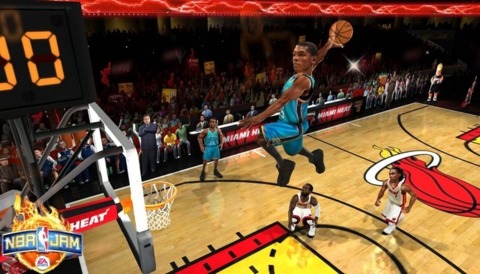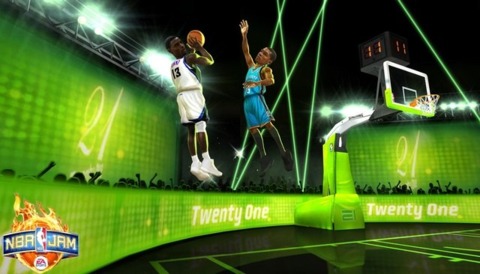NBA Jam session
GDC 2011: Creative director behind EA's 2010 multiplatform hoops game explains how the team decided what was kept and what was tossed for a new console take on the hit arcade franchise.
Who was there: EA Sports creative director Trey Smith was on hand for a presentation titled "Bringing back the 'BOOMSHAKALAKA!'"

What they talked about: Smith opened his talk by explaining the origin of the new NBA Jam, which wasn't an NBA Jam at all. At first, Smith was told to make a Wii basketball game for kids where the only thing players had to worry about was dribbling the ball virtually with the Wii Remote. The game became Bounce, which was an original intellectual property that was essentially inspired by NBA Jam. When they nabbed the NBA Jam license, Smith said the team partied like rock stars that night.
However, they woke up the next day and realized the enormity of the task ahead of them. In 1993, the original NBA Jam brought in $1 billion in arcades, Smith said. That's more than three times the highest-grossing film of the year, Jurassic Park.
To start with, Smith said the team invoked "The Sequel Rule of Thirds." One-third of the game had to be the same as before, to "take players back to their happy place." The next third of the game had to be improved over the original. Enhance the recipe, but don't change it so much that the audience doesn't like the taste anymore. The final third had to be all new, taking the franchise places it had never been before. But above all, Smith emphasized the need to be true to the source material.
As for what to keep the same in order to appeal to the hardcore fan base, Smith pointed to the arcade-style features of the original NBA Jam. It had to have over-the-top dunks, Big Head mode, players catching on fire, backboard-shattering dunks, and a strong multiplayer component. (He remembered it was a very rare sight to have just one person at the old four-player Jam arcade cabinets.) Finally, there was the amped-up play-by-play announcer yelling "BOOMSHAKALAKA!"
That announcer, Chicago actor Tim Kitzrow, wound up being part of the one-third of the game Smith said was kept the same. Mark Turmell was another returning face from the original NBA Jam development team. Turmell, who Smith described as "the godfather of arcade sports," was enlisted to work on the NBA Jam revamp a few months after development began.
Turmell had been working at EA's Tiburon studio at the time but went up to the Vancouver studio to help out in all facets of the game, Smith said, pointing out things he did on the original game that should be retained from the original. Specifically, Turmell had them lock the camera angle, allowing for incorporation of 2D and 3D elements. The team also put in loose ball cues, including a sound effect and flashing ball effect. There were also subtler things, like the way the size of the off-screen player triangle indicator changes depending on how far from the playfield they are. Additionally, players off-screen were significantly faster to help players get back into the game quicker if they needed to.
Turmell also told the team about the way goaltending in the game worked. In addition to letting players get away with goaltending roughly through 55 percent of a shot's arc, there was a random factor to the ref's calls, encouraging players to get up in arms with each other after a "blown" call by the ref. Finally, the veteran developer pushed for 60 frames per second on the Wii, something that Smith and the team weren't entirely sold on until they reached the goal and realized how much it added.
Moving to the improved third of the game, Smith decided to add a little more complexity beyond the arcade game's original three-button interface. He wanted to give the players more choices than "shove" or "be shoved," so he added a new spin move as well as an anklebreaker action that would send a defender into a stumble animation. Finally, they wanted to bolster the co-op experience with alley-oop dunks. They put the alley-oop dunks in for focus groups and brought in a bunch of early teenagers to play the game. The session started off quietly, but all of a sudden things picked up when one group of players figured out the alley-oop, and the room soon erupted with players loudly coordinating their co-op dunking tactics and defenses.
Smith also said it was important for them to improve the visuals of the game. He wanted to make sure they could get digitized player images in the game, partly because NBA Jam was among the first sports games where player likeness was ever taken into account. But considering how difficult rendering every player in photo-realistic detail could be, Smith opted for 3D bodies with 2D cutout heads featuring minimal animation.

On to the new stuff, Smith talked about breaking the game in half. He found that a lot of older players balked at the idea of a single power-up on the court, so he wanted to have a mode for purists and a mode for those willing to mix it up. The new feature that got the most attention was Backboard Smash, a four-player mode where the object of the game was to break the backboard in a mode described as "NBA Jam meets Street Fighter." Motion controls were also new, but Smith was insistent on how they were incorporated. He believed any motion controls had to be intuitive, responsive, and satisfying. As Smith said, it's much more satisfying to mimic a jam in the opponent's face than simply pushing a button on a controller. On the other hand, nobody wanted to shake the remote every time they wanted to dribble the ball.
"We've all seen the waggle," Smith said. "It makes me want to vomit."
If a particular gesture didn't meet all three of the criteria, Smith said the command was moved to a button instead.
Looking back on the game, Smith said the Rule of Thirds worked well. NBA Jam on the Wii captured the old-school fans of the arcade game, showing that the content that was kept the same worked. The visual style and 2D heads also drew some acclaim, making the improvements third of the game a success. Finally, Smith said the motion controls enhanced the game for many of those who were willing to give it a try, enough to make the third of the game that was new qualify as a success.
When asked by an audience member about the game's intended inclusion with NBA Elite, Smith said his team was on the outside of that decision. He called it a tragedy anytime a game doesn't ship, saying it was a talented team that just couldn't pull everything together to meet the release date at the required quality level. Smith said since his team didn't have control over Elite or the promotion of the Xbox 360 and PlayStation 3 versions tied to it, he said they tried instead to focus on what they did have control over. He also detailed the game's changing exclusivity, saying it had been intended to be a Wii exclusive until after it was shown at the Electronic Entertainment Expo to positive feedback and numerous requests for PS3 and Xbox 360 versions.
Another member of the audience asked about Tag mode, which would have players control whichever player on their team had possession of the ball at the moment. Smith said he was being true to the original arcade NBA Jam in restricting control to just one player during the game, but added that in retrospect, it was probably the wrong decision. If he had the chance to do it again, Smith said the first thing he'd add in is the Tag mode. As for a possible arcade release of the game, Smith said he'd love to, but there aren't any plans for a coin-op version right now.
Quote: "Our holy grail was that original arcade cabinet, and every decision was made to be as true to that game as possible."--Smith, on being true to the source material.
Takeaway: Smith and his team had the intimidating task of reviving a moribund--but still beloved--franchise in NBA Jam. While people may disagree on how well the final product captured the spirit of the original, there's little room to dispute the knowledge of and passion for the series the team put into the game.
Kingdom Come: Deliverance 2 - Official Cinematic Announcement Trailer Stellar Blade - BIBI ‘Eve’ Official Music Video Trailer | PS5 Apex Legends: Urban Assault Collection Event Trailer Total War: WARHAMMER III - Elspeth von Draken Gameplay Showcase Genshin Impact - "Arlecchino: Sleep in Peace" | Official Character Teaser Potionomics: Masterwork Edition - Official Announcement Trailer Snowbreak: Containment Zone - "Gradient of Souls" Version Trailer Harold Halibut GameSpot Video Review Nancy Drew: Mystery of the Seven Keys | World Premiere Official Trailer Modern Warfare III & Warzone - Official Cheech & Chong Bundle Gameplay Trailer SteamWorld Heist II – Official Reveal Gameplay Trailer Dead Island 2 – Official SoLA Expansion Gameplay Launch Trailer
Please enter your date of birth to view this video
By clicking 'enter', you agree to GameSpot's
Terms of Use and Privacy Policy
Got a news tip or want to contact us directly? Email news@gamespot.com
Join the conversation